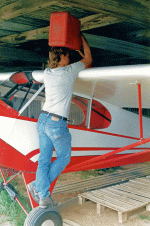Piper J3
Well Known Member
A slow news day, so I’ll share a thought…. It’s very easy to pull up to a gas pump and fill tank with fuel and not have any direct association with how much weight you have added to the aircraft. Today I hauled four 5-gallon containers of mogas out to the airplane. 20 gallons is fuel capacity of RV-12. Each container weighs about 30 pounds, so 120 lbs total. Wow….
In my youth (a few years ago) I used to lift the 5-gallon containers and pour directly into the airplane filler neck. I had to hold heavy container while fuel flowed slowly through small snout. Now I have FLO-FAST hand crank fueling pump to do the heavy lifting for me… not to be confused with Flomax which has entirely different use
The Rotax 912 is a small engine @ 1352CC. Almost the same displacement as mid-60’s VW Beetle. It amazes me that the RV-12 airframe and engine are so perfectly matched. Two 200-pound people, 20-gallons fuel, and 50-pounds baggage is still under gross weight and yet the machine climbs 900 fpm and flies 130mph using only 5 gph. Pretty good trick, if you ask me….
In my youth (a few years ago) I used to lift the 5-gallon containers and pour directly into the airplane filler neck. I had to hold heavy container while fuel flowed slowly through small snout. Now I have FLO-FAST hand crank fueling pump to do the heavy lifting for me… not to be confused with Flomax which has entirely different use
The Rotax 912 is a small engine @ 1352CC. Almost the same displacement as mid-60’s VW Beetle. It amazes me that the RV-12 airframe and engine are so perfectly matched. Two 200-pound people, 20-gallons fuel, and 50-pounds baggage is still under gross weight and yet the machine climbs 900 fpm and flies 130mph using only 5 gph. Pretty good trick, if you ask me….





